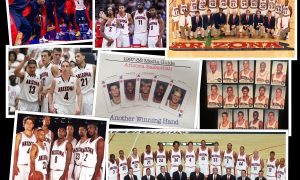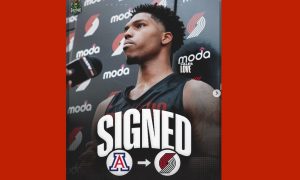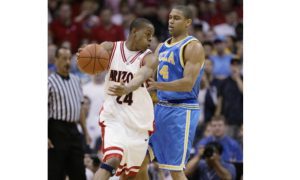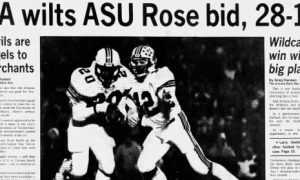|
|
|
ARIZONA PRODUCTIVITY RATING
[table “” not found /]
GLOSSARY:
G: Games played. S: Number of starts.
BP: Bench points. A player gets three points if he is first off the bench, two if second and one if third. Shows Sean Miller’s rotation.
UW: Productivity points against Washington
WMIN: Minutes played against Washington
PP: Productivity Points (Points, assists, rebounds, steals, blocked shots, FGs made, FTs made added together and then subtracted by missed FGs, missed FTs, personal fouls and turnovers)
TMIN: Minutes played overall
PR: Productivity rating per minute played (Productivity points divided by minutes played)
NOTE: Player must average at least 10 minutes a game to be listed in primary rotation
Sometimes coaches will take a win on the road no matter the circumstance, especially at a place where Arizona coach Sean Miller had yet to win.
That’s what happened Thursday as Arizona triumphed 57-53 over Washington at the Alaska Airlines Arena, better known as Hec Edmundson Pavilion. Miller can check a win at Washington off his bucket list — the Huskies are the last Pac-12 team he has beaten on the road — but he would have preferred a lot more buckets in the process.
The Wildcats’ primary eight-man rotation managed only 66 productivity points (see glossary for explanation) in 197 minutes. The UA’s only worse output this season was 65 productivity points in a 70-66 loss at Oregon on Jan. 10.
Arizona managed the victory because of another productive showing by sophomore guard Nick Johnson, who posted 26 productivity points in 34 minutes. He now leads the Wildcats with a productivity rating of .660. His most valuable contribution was shutting down Washington guard C.J. Wilcox — the Huskies’ lifeline — defensively.
Wilcox finished with only 11 points on 4-of-16 shooting from the field thanks mostly to Johnson’s continuous pursuit. One snapshot of the game was Johnson readjusting his body in midair and blocking a Wilcox jumper in the first half. Johnson had a team-high 15 points with three blocked shots and four of Arizona’s five steals.
“I was looking forward to it coming in,” Johnson was quoted as saying by the Associated Press about the matchup with Wilcox. “I feel like I played hard. I think I did a good job. He’s a great player. He can score with the best of them.”
Miller looked relieved with the victory at the end of the game, but he and his staff must have convened afterward and talked about the game being too close for comfort. This is similar to last week when Arizona lost to UCLA and became refocused with a resounding 74-50 win over USC.
Washington, on a four-game losing streak, including a home loss to Pac-12 last-place team Utah, is adjusting this season without Tony Wroten and Terrence Ross, who bolted to the NBA after their sophomore seasons. The Huskies rely heavily on Wilcox and 7-foot senior center Aziz N’Diaye.
The only reason why the game was in doubt with a minute remaining — and not overwhelmingly in Arizona’s favor — is because the Wildcats had only seven assists with 17 turnovers and they shot 3-of-18 from three-point range. Many of those three-point attempts were not within the flow of the UA offense. A couple of them were heaves to beat the shot clock.

Sean Miller will gladly take the win on the road but he will stress improvement against Washington State (ESPN video/click on picture to access video)
Arizona senior point guard Mark Lyons (5-of-14 from the field, including 0 for 4 from beyond the arc, and three turnovers with only one assist) had only two productivity points in 34 minutes. That’s two less than his output last week in an 84-73 loss to the Bruins.
To put it bluntly, if Washington was a quality opponent, the outcome would have been different.
“To win on the road when you don’t play offense well or have a half like we did, I think is a telling sign that hopefully our future is filled with some good moments,” Miller was quoted as saying by the Associated Press.
Miller was talking about the first half, in which the Wildcats trailed 16-5 almost nine minutes into the game. Arizona rallied with a 16-4 run to take the lead but then went cold again. Washington scored the last six points of the half to take a 28-23 lead at intermission. The Wildcats were unable to get a shot off on their last possession before the buzzer sounded.
Miller walked toward the locker room shaking his head in disgust.
“We have to learn to trust each other,” senior Solomon Hill was quoted as saying by the Associated Press. “It was a factor of wearing them down in the second half and playing together and that’s when we started getting easy ones and Nick made a bunch of defensive stops and we just stayed with them.”
Whereas last week’s loss to UCLA was because of missed opportunities with high-percentage shots, Thursday’s escape against Washington was a result of not setting up scoring opportunities because of turnovers and forced shots.
The bottom line: Arizona won and is now 18-2 overall and 6-2 in the Pac-12.
Arizona has not started 18-2 in a decade, when Jason Gardner and Luke Walton and Co. finished 28-4 and advanced to the Elite Eight in 2002-03.
Miller can also feel assured that the future looks bright with freshman center Kaleb Tarczewski, who mostly held his own against the more experienced N’Diaye. Tarczewski was second on the team with 15 productivity points in 29 minutes. He made 6-of-7 free throw attempts with a team-high eight rebounds and 10 points.
Tarczewski did not score in the second half, but his production in the first half kept Arizona afloat.
Defensive Rebounding Percentage (DRB%): Determined by dividing Arizona’s defensive rebounds (22 against Washington) by the opposition’s offensive rebounds (Washington had 12) added to Arizona’s defensive rebounds (22) — 22/(12 + 22) = 64.7 percent.
Offensive Rebounding Percentage (ORB%): Determined by taking Arizona’s offensive rebound total (14) divided by that total (14) and the defensive rebounds of the opponent (23 for Washington) — 14/(14+23) = 37.8 percent.
Ideal marks are 75 percent DRB% and 40 percent ORB%.
|
DEFENSIVE/OFFENSIVE REBOUNDING% [table “” not found /] |
Site publisher, writer and editor Javier Morales is a former Arizona Press Club award winner
[rps-paypal]
|
|






























